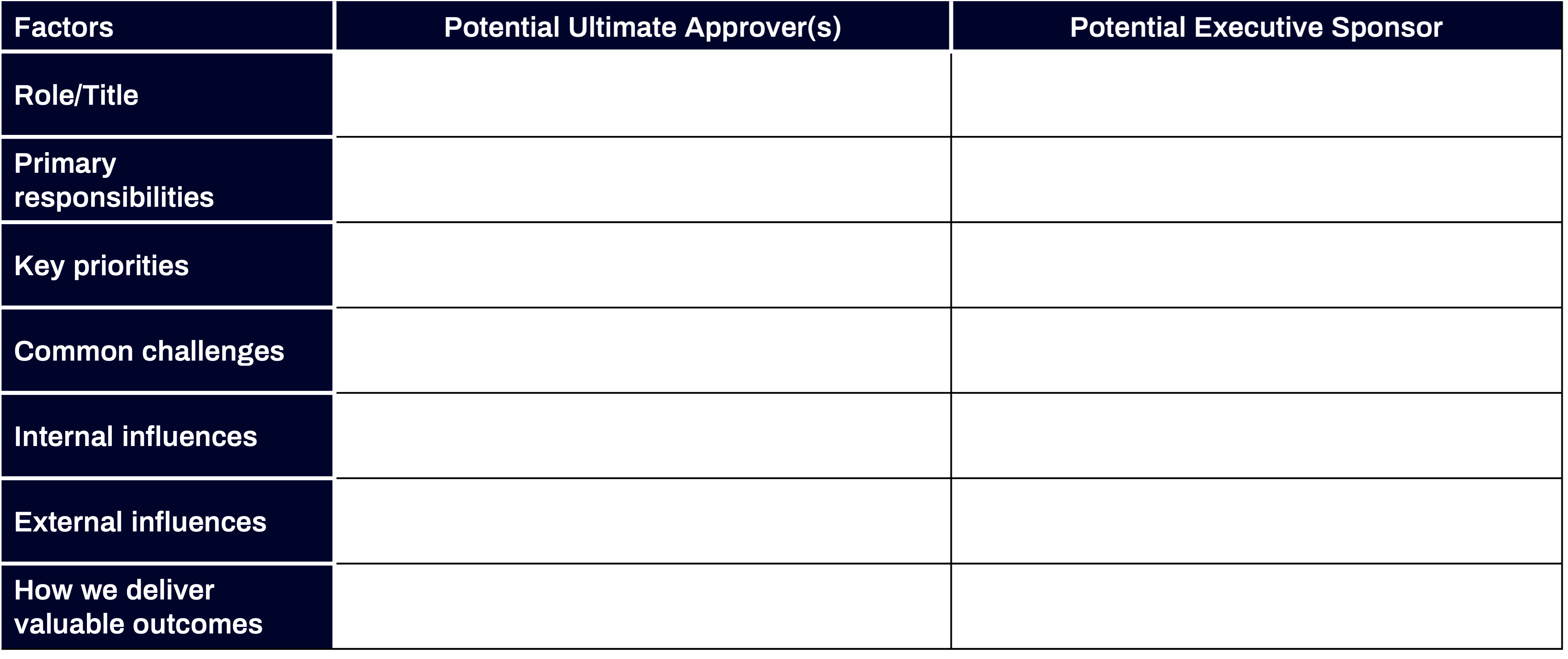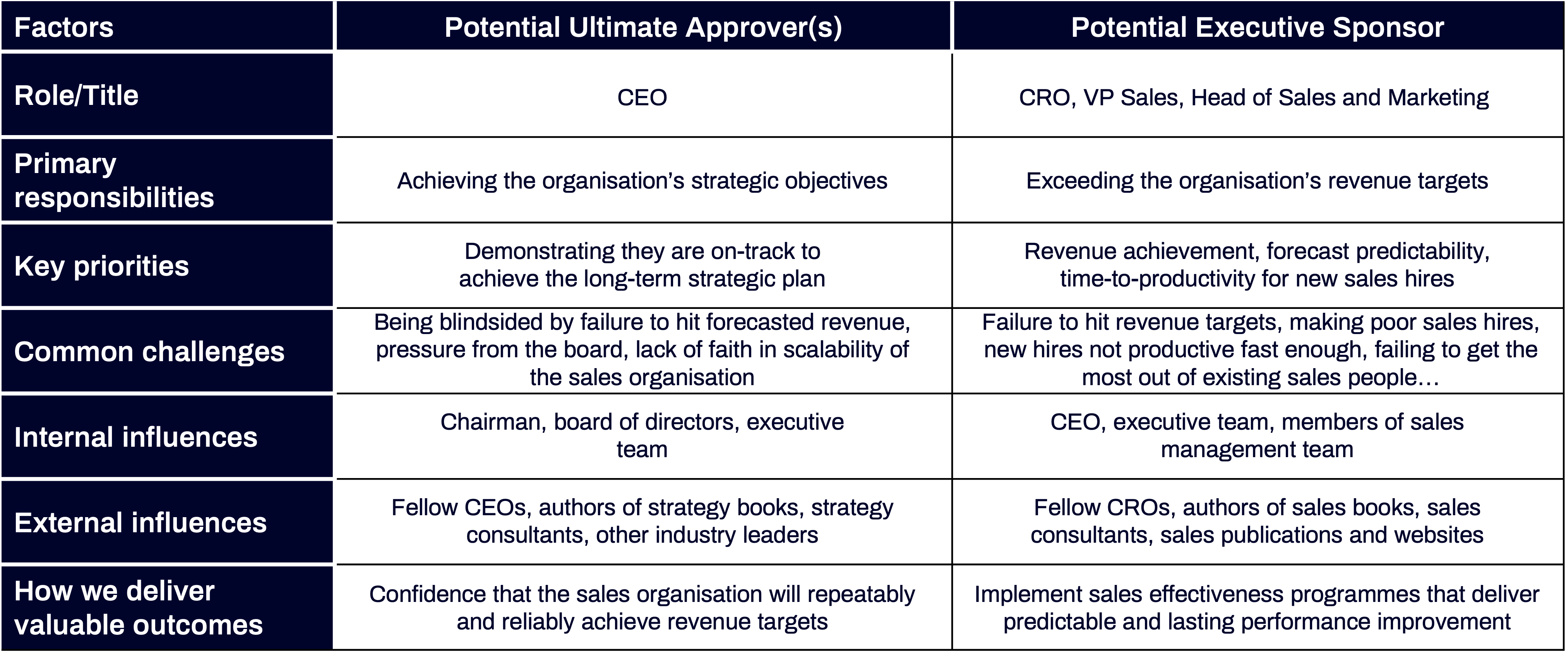Profiling the Key Roles in your Ideal Customers
March 11, 2024

In the previous article in this series on Outcome-Centric Selling® I addressed the importance of identifying and targeting the common characteristics of our ideal customers - and now I want to turn our attention to identifying and targeting the key roles within those most valuable potential customers.
In this context, “key roles” means the powerful stakeholders within your ideal customers who are most likely to be responsible for dealing with the issues you have chosen to target. There will probably be many people who are interested in the issue - but our goal must be to anticipate, identify and target the ones who are most likely to actually be able to do something about it.
If we choose to engage people who are interested in the issue but have no authority or influence over the resulting decision-making process the resulting “opportunity” is likely to get stuck at an early stage - unless our initial approach is part of a thoughtful, well-researched strategy to reach the real decision-makers.
Key Roles
Today’s complex B2B buying decisions typically involve multiple stakeholders - depending on which of the latest studies you read, the average is often between 8-12 and in some situations there can be even more. But, of course, they are not all created equal - and that’s why the sooner we identify and engage with the stakeholders that have the greatest influence, the better.
Here are some of the key things we need to know:
- Who are the people within our ideal customers who are most likely to act as the executive sponsors and ultimate approvers of the project or initiative intended to address the issue?
- What are their most common roles or titles?
- What are people in these positions typically responsible for? What do they care about? How is their success measured?
- How can we identify, reach out to, and engage these individuals?
The key principle, of course, is that we need to focus our energies on the people who are not just interested in the issue, but who can actually make change happen. As I’ve suggested, two roles tend to be particularly important - the executive sponsors and the ultimate approvers.
Executive Sponsors
The executive sponsor is often the operational head of the department or function most affected by the issue. They play a key part in navigating the project through the organisation but will often delegate detailed aspects of the decision-making process to functional experts.
When it comes to money, depending on the sums involved, they may themselves have the ability to reallocate budget - or if not, they know how to influence the economic buyer. And even if they initiate the project, they may need to “sell it” to the ultimate approver(s) in order to get the order approved.
These roles:
- Typically have shorter-term urgent business performance issues they need to address now
- Prioritise projects and initiatives that enable them to achieve their short-term goals
- Often attracted by “destination” messages that talk to their current business challenges and opportunities
- Need to be reassured that their investments will pay off in both the short- and long-term
- Evaluate vendors for their ability to tactically execute the current project
Ultimate Approvers
The ultimate approvers (sometimes referred to as the “economic buyers”) are the people who have the final authority as to whether or not the project goes ahead. They are always able to reallocate budget to fund their top priority initiatives.
They may initiate the project, but if they do, they may not want to be involved in the detail - relying on (or delegating to) an executive sponsor and the decision-making team to drive the project forward on a day-to-day basis.
These roles:
- Typically have a longer-term vision of where they want their organization to look like in the future
- Support projects and initiatives that support both their long-term goals and short-term priorities
- Often attracted by “journey” messages that paint a picture of a better future
- Need to be reassured that their investments will pay off in both the long- and short-term
- Evaluate vendors as potential long-term strategic partners
Either of the above two roles is capable of initiating a project - but both roles are usually critical to achieving a successful sales outcome (together, of course, with the other stakeholders).
Engaging these Key roles
It’s important that we use language, themes and messages that are relevant to their respective roles, responsibilities, and interests.
Key themes and messages for the Executive Sponsors include:
- Common business challenges faced by similar executives in similar organizations
- Positioning our approach to addressing these issues as being different (and delivering better outcomes)
- Offering to share how we’ve helped their peers to master these issues
Key themes and messages for the Ultimate Approvers include:
- Unarguable, inevitable, unavoidable changes in their business environment
- Offering a fresh perspective on the strategic implications for their organization
- Offering to share how we’ve helped other business leaders to transform their organizations
Profiling the Key Roles
Here are some of the key factors we need to consider when thinking about the typical attributes (or “buyer personas”) of people in the key roles we are intending to target:
- What are the typical job titles associated with each of the key roles we have chosen to target?
- What are the typical primary strategic and operational responsibilities of each of these key roles?
- What are the typical key priorities of each of these key roles (with particular regard to the issues we have chosen to target)?
- What are the common challenges facing each of these key roles (with particular regard to the issues we have chosen to target)?
- Who are they typically influenced by internally (in order to identify other potential key stakeholders)?
- Who are they typically influenced by externally (advisers, consultants, trade organizations, professional bodies, media and so on)?
- How do we typically support the objectives of each of these key roles and deliver valuable outcomes for them?
I suggest using a one-page worksheet to anticipate and summarise the generic attributes and characteristics of the roles we typically need to focus on - and then seek to refine our hypothesis in the course of our day-to-day conversations with the people who occupy these specific roles in each actual opportunity:

And here’s an example of a completed worksheet - notice how these roles have different but related attributes:

From the general to the specific
These worksheets can help us to develop an informed hypothesis about the likely attributes of key roles, guide our outreach, and prepare for our initial conversations - but we should always overwrite this with our account-specific research and with what we discover through conversation with each actual individual.
Quick Summary: Targeting Key Roles
Here’s my quick summary of the key takeaways from this article:
- The two key roles we always need to target are the executive sponsor and the ultimate approver(s) - both are likely to be important
- The people in these roles are likely to respond to different messages and themes
- If we misjudge this in our outreach, we may never be able to initiate a conversation with these roles
- If we misjudge this in our initial conversation, we may kill an otherwise promising opportunity
- We need to understand and anticipate each roles’ likely primary responsibilities, key priorities, common challenges, internal and external influences and how we could deliver valuable outcomes for them
Putting these principles into practice
Whether you’re an experienced salesperson or a relative newcomer, here are some guidelines that we hope you’ll find helpful:
- Analyse your most valuable customers and prospects
- Identify and profile the key roles you typically expect to engage with
- Research the people in these roles in the organisations you intend to target
- Anticipate the specific messages and themes each of these individuals is likely to respond to
- Share your conclusions with your colleagues who are targeting similar potential opportunities - and learn from each other
- Keep tuning these messages and themes in the light of what people most frequently respond to
Learn more
If you’d like to learn more (and download an editable version of the framework), please sign up for our academy course on the subject (or even better, subscribe to the whole academy).
I’ve said before that becoming outcome-centric is a journey, not a destination. There will always be ways in which we can increase the probability that every customer will recognise the value of our offerings in terms of the business outcomes we enable them to achieve. And the sooner we start the journey, the further we will progress down that path.
In the next article in this series, we’ll shift our focus to identifying the trigger events that are most likely to persuade the key roles in our ideal customers to pay urgent attention to the issues we have chosen to target. In the meantime - if you haven’t already done so - you might want to download our guide to Outcome-Centric Selling.


Comments